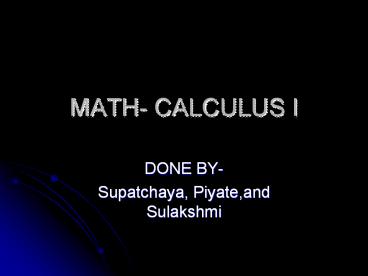MATH-%20CALCULUS%20I - PowerPoint PPT Presentation
Title:
MATH-%20CALCULUS%20I
Description:
MATH- CALCULUS I DONE BY-Supatchaya, Piyate,and Sulakshmi PROBLEM 1 Under what conditions will the decimal expansion p/q terminate? Repeat? PROBLEM 2 Suppose that we ... – PowerPoint PPT presentation
Number of Views:139
Avg rating:3.0/5.0
Title: MATH-%20CALCULUS%20I
1
MATH- CALCULUS I
- DONE BY-
- Supatchaya, Piyate,and Sulakshmi
2
- PROBLEM 1
- Under what conditions
- will the decimal expansion p/q
- terminate? Repeat?
- PROBLEM 2
- Suppose that we are given
- the decimal expansion of a rational number. How
can we represent the decimal - in the rational form p/q?
3
PROBLEM 3
- Express each of the following repeating
decimals in the rational number form of p/q. - (a) 13.201 (b)0.27 (c)0.23 (d)4.163333..
- Show that the repeating decimal
- 0.9999. 0.9 represets the number 1.
- Also note that 1 1.0.
- Thus it follows that a rational number may have
more than one decimal representation. - Can you find any others?
4
SOLUTIONS
5
SOLUTION 1
- The decimal expansion of p/q can be represented
as p(1/q) - The cases when it will terminate is if the value
of p and q is equal to zero - The other cases when it will terminate is
explained as follows
6
EXPLANATION
- Lets assume that the value of q to be from 1 to
15. - In all the cases the value of p remains the same
.i.e. 1 - On calculating we get the following results
7
CALCULATION
- 1/1 1
- 1/2 0.5
- 1/3 0.333..
- 1/4 0.25
- 1/5 0.2
- 1/6 0.16666..
- 1/7 0.142857142857..
- 1/8 0.125
- 1/9 0.1111111.
- 1/10 0.1
- 1/11 0.090909
- 1/12 0.833333
- 1/13 0.0769230769230
- 1/14 0.0714285714..
- 1/15 0.06666..
8
CONCLUSION
- We notice in the above calculations that the
decimal expansion p/q will terminate when the
value of q is 2 or 5. The epansion will
terminate even if the value of q is a factor of 2
or 5. - The value of p will repeat when the value is
neither 2 or 5 or a multiple of 2 or 5.
9
SOLUTION 2
- We can represent all decimal function as a
rational number. - For Example - 7.9
- 5.55
- 998.21
79 10
555 100
99821 100
10
EXPLANATION
- In the case of repeating decimal numbers like
- 0.333333 or 0.0909090
- it is very impossible to present the decimal
function as a rational number as it is infinite. - So we use the geometric series to find the
result. - In this case we will use the decimal 0.33333
- and represent it as a rational number through
the geometric series.
11
CALCULATION
3 10
3 100
3 1000
3 10000
- 0.3 .
- GEOMETRIC SERIES , iff -1lt r lt1
- This is a geometric series with a and r
0.1 - So, 0.3
a 1-r
3 10
1 10
3/10 (1- 1/10)
3/10 9/10
12
- So the value of 0.3333.equalizes to
- 3/9 which on simplification is 1/3.
- CONCLUSION
- This is how we can represent the a repeating
decimal function in the rational form.
13
SOLUTION 3
- We will use the geometric series to solve
the following problem. - GEOMETRIC SERIES , iff -1lt r lt1
- a) 13.201201201
- Here a ,and r
- ___
- 13.201 13
- 13 / (1 -
) - 13
- 13
a 1-r
201 1,000
1 1,000
201 1,000
201 10,000
201 1,000
1 1,000
201 1,000
1,000 999
201 999
201 999
12987 999
4396 333
14
- b) 0.272727.
- Here a ,and r
- __
- 0.27
- / (1 - )
27 100
1 100
27 100
27 10,000
27 100
1 100
27 100
100 99
27 99
3 11
15
- c) 0.2323232323232..
- Here a ,and r
- __
- 0.23
- / (1 - )
23 100
1 100
23 100
23 10,000
1 100
23 100
23 100
100 99
23 99
16
- d) 4.1633333.
- Here a ,and r
- _
- 4.163 4
- 4
/ (1 - ) - 4
- 4
- 4
3 1,000
1 10
16 100
3 1,000
3 10,000
16 100
3 1,000
1 10
16 100
3 1,000
10 9
16 100
1 300
48 300
1200 48 300
1248 300
312 75































